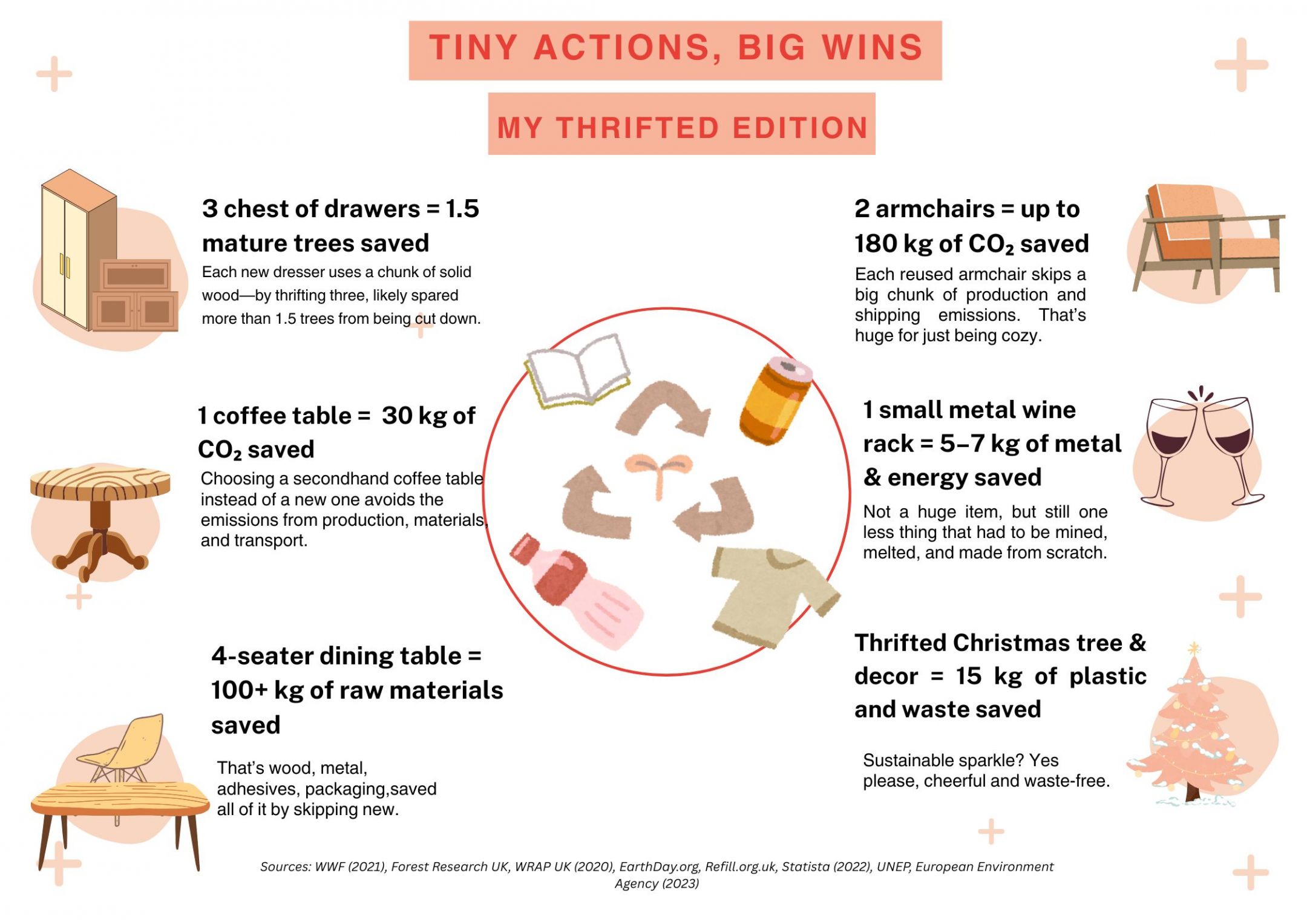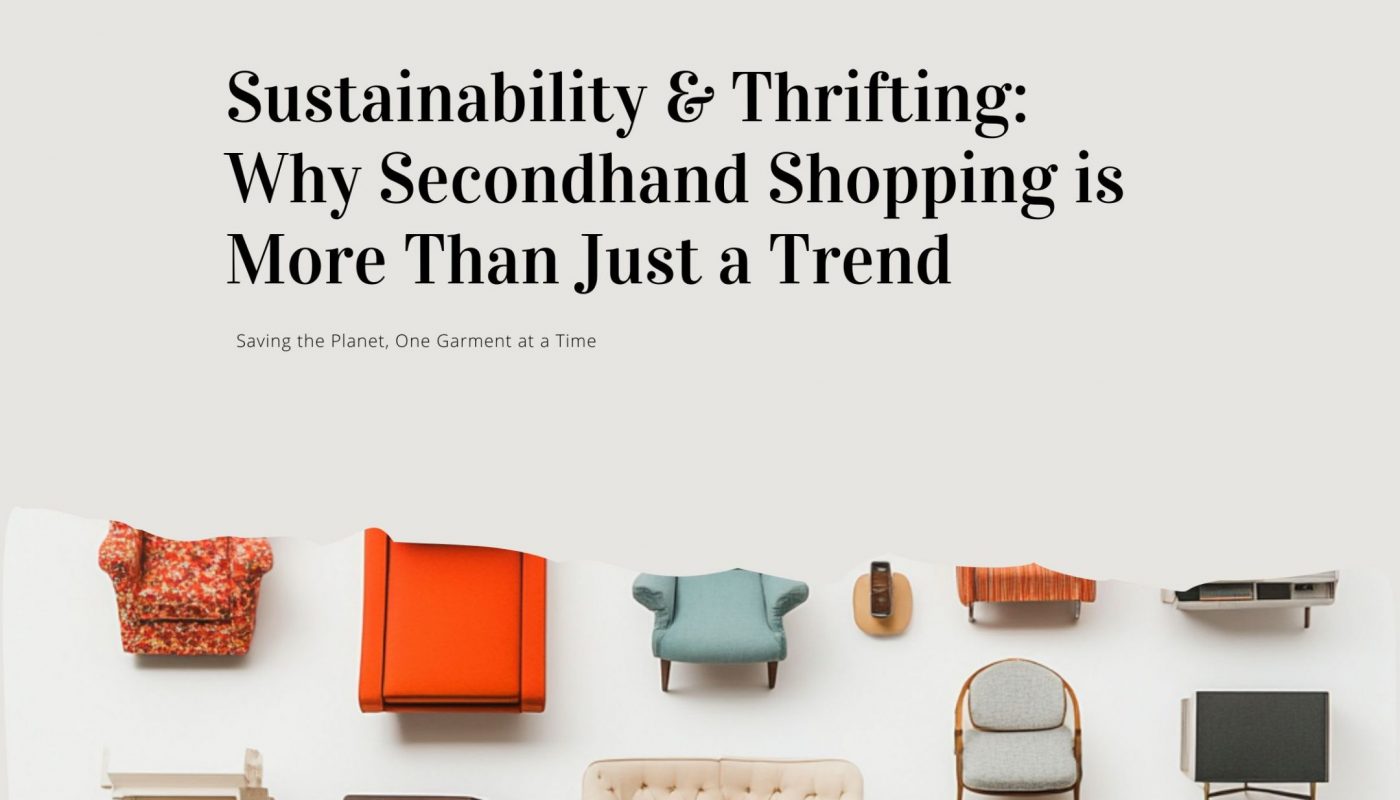Sustainability wasn’t actually the reason I got into thrifting. If I’m being honest, it started purely as a budget-friendly move. We had just bought a new house and already stretched the budget, so finding affordable, unique pieces felt like the smartest way to make the space feel like home—without spending a fortune.
I know sustainability is everywhere now—ads, influencers, even shampoo bottles. And while I get the importance, I’ve never really chosen it over convenience. It just hasn’t been my main motivator.
But then I came across this Reddit thread—people sharing how small actions like buying secondhand or repairing stuff saved a ton of carbon emissions and water. And it hit me: I’ve kind of been doing that, just… not on purpose.
So no, this blog post isn’t about how my lifestyle is perfectly sustainable because I thrift. It’s not. But I have learned some pretty cool things about the impact of secondhand shopping—stuff that might inspire someone who is into that. Or maybe just make you realize, like I did, that some of our choices matter more than we think.
Let’s get into it.
🌍 EU-Wide Stats: The Eco-Power of Reuse
-
Reusing textiles = 70x less harmful than producing new ones. That’s a huge difference.
-
Every pre-loved item = about 3 kg of CO₂ saved, plus a big drop in water usage.
-
But… 62% of used clothes still end up in the trash in Europe. Which feels kind of tragic, tbh.
-
Choosing secondhand can cut a product’s carbon footprint by up to 75%. That’s like the eco version of a discount.
-
Refurbished tech? A game-changer. Buying a secondhand phone avoids most of the emissions tied to producing a brand-new one.
-
A 10% increase in secondhand sales in the fashion industry could cut carbon emissions by 3% and water usage by 4%. So yeah, that old teapot you bought kinda helps.
🇨🇭 Switzerland: Low-Key Circular Economy Champions
-
Switzerland collects about 50,000 tonnes of textiles per year for reuse. That’s a lot of potential outfits and curtains with stories.
-
Thrift stores here (like Caritas and Salvation Army) are community-run and often support local charities—so your cool decor find might’ve helped someone else too.
-
The “Strengthening the Swiss Circular Economy” policy (2024) officially puts reuse before trashing things. About time.
💻 Digital Recommerce: Thrifting Goes Online
-
Platforms like Ricardo.ch, Tutti.ch, and Vinted are making it super easy to buy and sell secondhand stuff—from vintage mugs to phones that still work just fine.
Now, I’ve never really been the type to sit down and calculate my “independent contributions” to the planet or claim I’m doing this all for the greater good. I thrift because I enjoy it—it’s affordable, fun, and let’s be real, half the time I don’t even realize I’m making a sustainable choice.
But I got curious. I wanted to see what those choices actually meant. So I asked AI to help me quantify some of the secondhand things I’ve picked up over time—just to get an idea of the impact (even if it’s not 100% precise or world-changing).
Turns out, putting numbers to these actions? Kinda satisfying. It made me think—how cool would it be if we all just made a few sustainable swaps, here and there? Not to be perfect. Just to be a bit more mindful.
Here’s a little poster I made based on what I found:

Sources
Adevinta. (2020). Second hand effect report 2020. https://www.adevinta.com
Caritas Switzerland. (n.d.). Second-hand programs. https://www.caritas.ch
European Environment Agency. (n.d.). Swiss Environmental Protection Act revisions (Parliamentary initiative 20.433, 2020–2024). https://www.eea.europa.eu
European Recycling Industries’ Confederation. (2023). Study on textile reuse. https://www.recycling-magazine.com
Swiss Federal Office for the Environment. (n.d.). Guidance on textile reuse. https://www.bafu.admin.ch
Vinted. (2021). Climate impact report (2021 data). https://www.theindustry.fashion
I ’ve slowly (but very surely) adapted my shopping habits to include more online secondhand finds. Don’t get me wrong—I love the feeling of walking into a thrift store, touching things, spotting the weird and wonderful gems you didn’t even know you needed. But let’s be honest… time isn’t exactly on our side these days. So more often than not, I find myself flipping between online and offline thrift hunting depending on the mood (and my calendar).
In my next post, I’m going to dive into how I used these platforms—especially Ricardo and Tutti—to thrift pieces for my home. I’ll even share how I put together mood boards to figure out what I actually needed (and wanted), and how the whole process came together piece by piece.
Stay tuned—it’s going to be part design inspo, part thrift treasure map. 👀🛋️✨
If you’re into thrifting, styling on a budget,check out my other blog posts here.




I don’t trifft a lot but it’s always a good idea to use the object if it’s still usable 🙌 it’s both environmental and financial sustainable I love it!
Yup… exactly 🙂
Really interesting read—nice to know secondhand can be both budget-friendly and sustainable! ♻️💸
Thank you 🙂
Really Nice, didn’t know about the online options.. do you recommend any in particular for Switzerland?
Ricardo is my go to 🙂 I will share more in my next post !!
Sper honest and relatable post! It’s refreshing to see someone talk about practicality and budget perspective of thrifting. The stats and the effort is very commendable and here’s looking forward for the next mood board. Thanks for sharing this experience!
To be hosent, your blog inspired me! I needed a new spring jacket and found an amazing one on Ricardo!
Thank you so much 🙂
So me! The vibe of physical thrift stores is unmatched, but with limited time, online secondhand shopping is such a lifesaver…
I really agree with your view on secondhand shopping. I especially do it to find treasurable finds while contributing as little as possible environmental impact.
That is amazing :)))